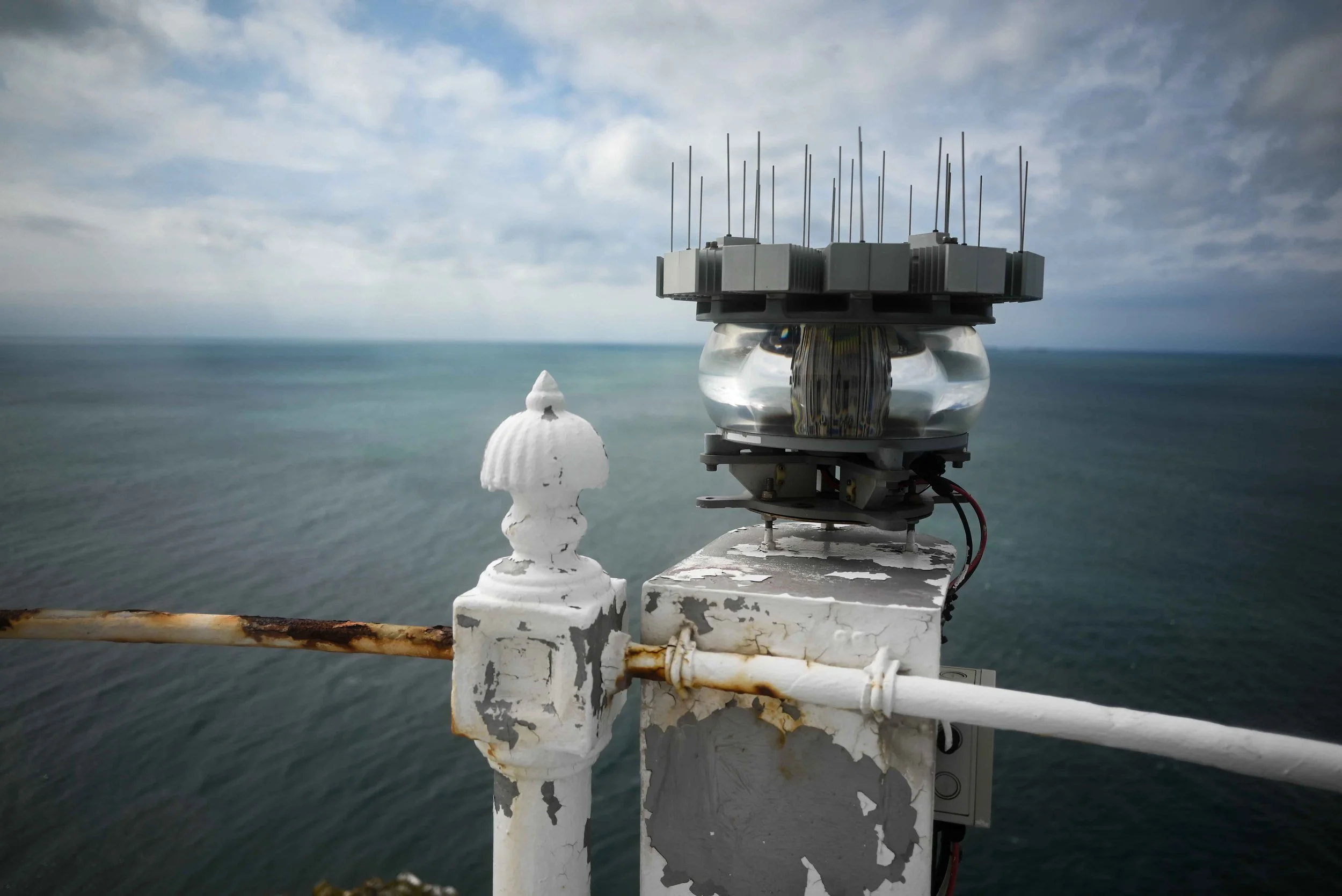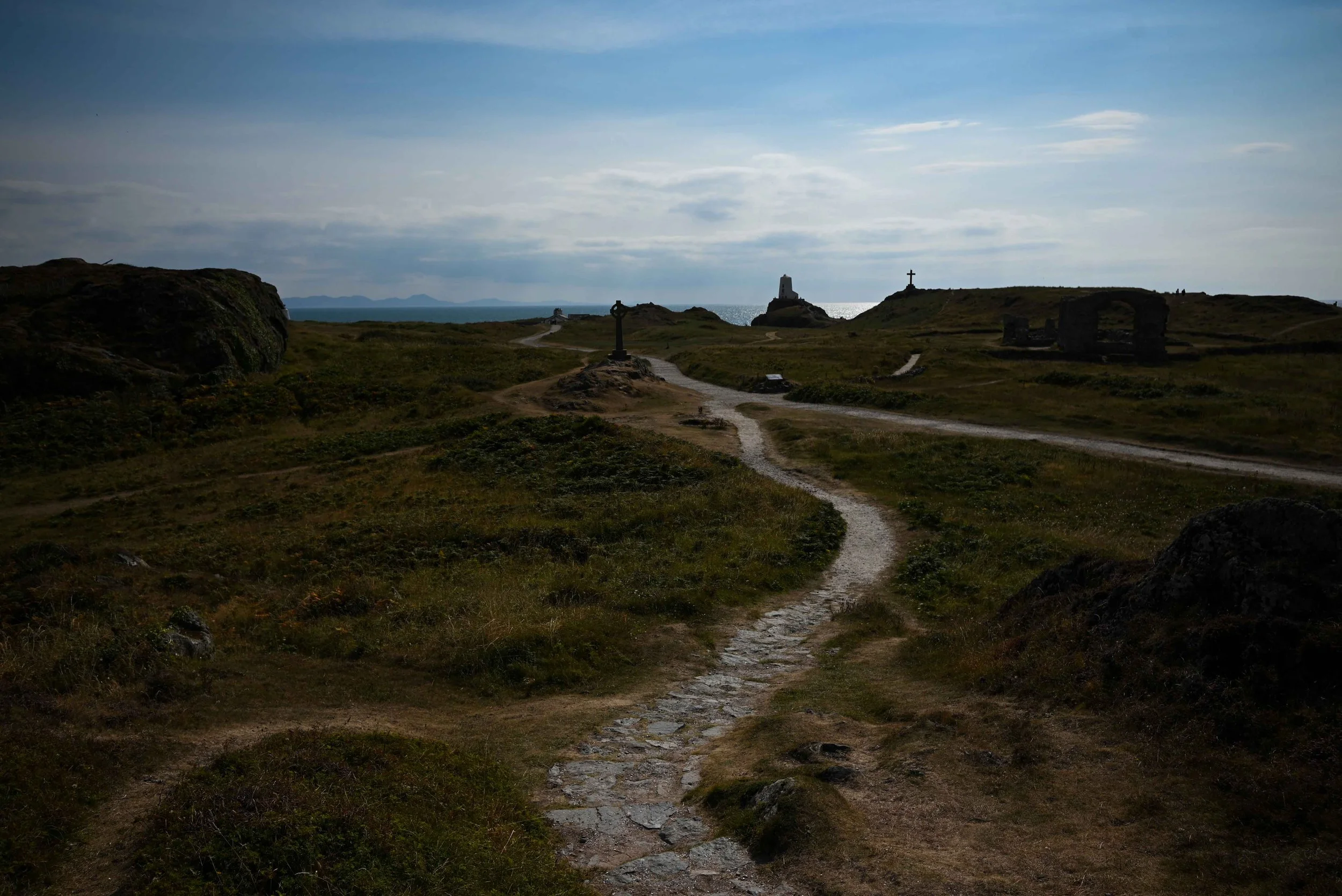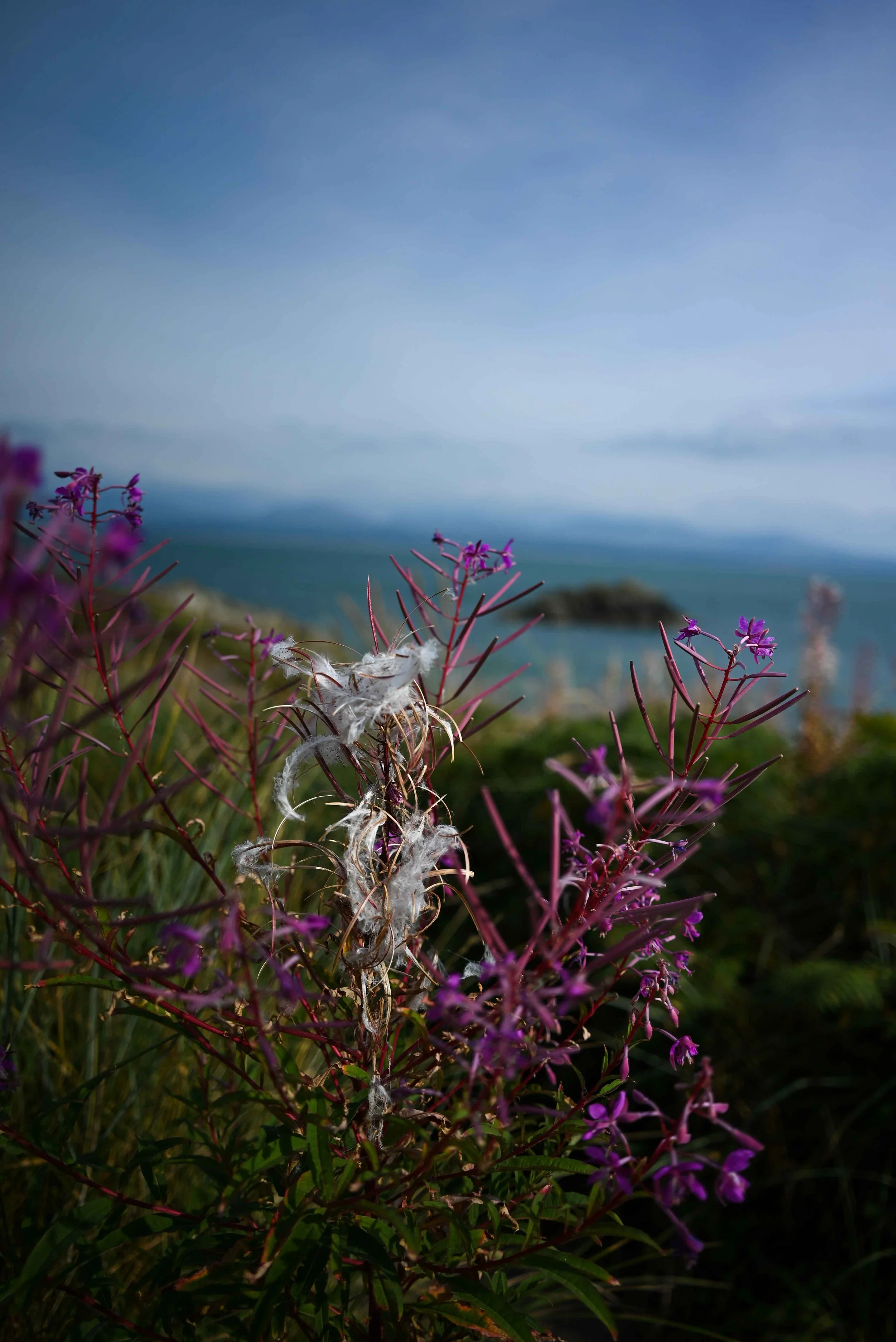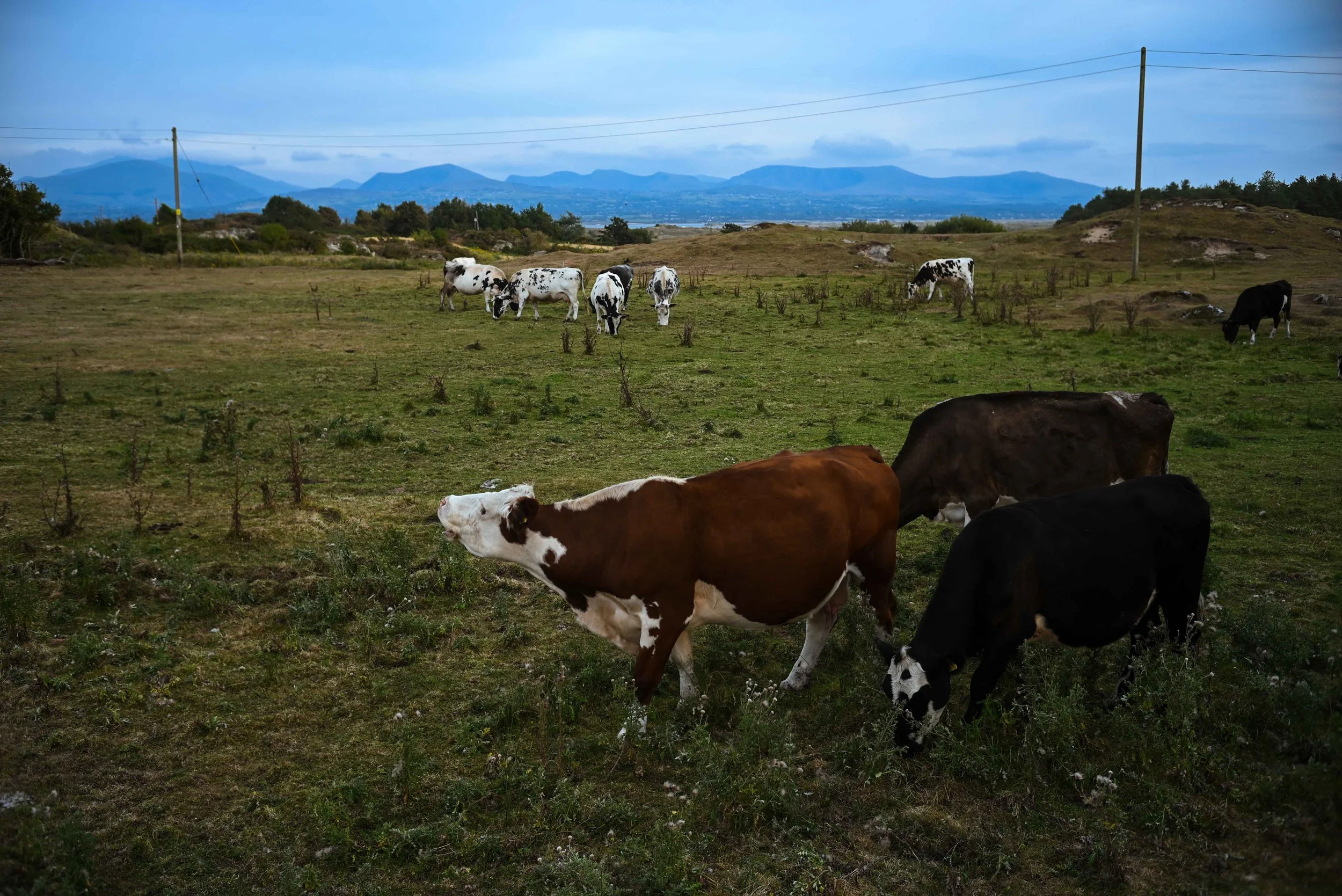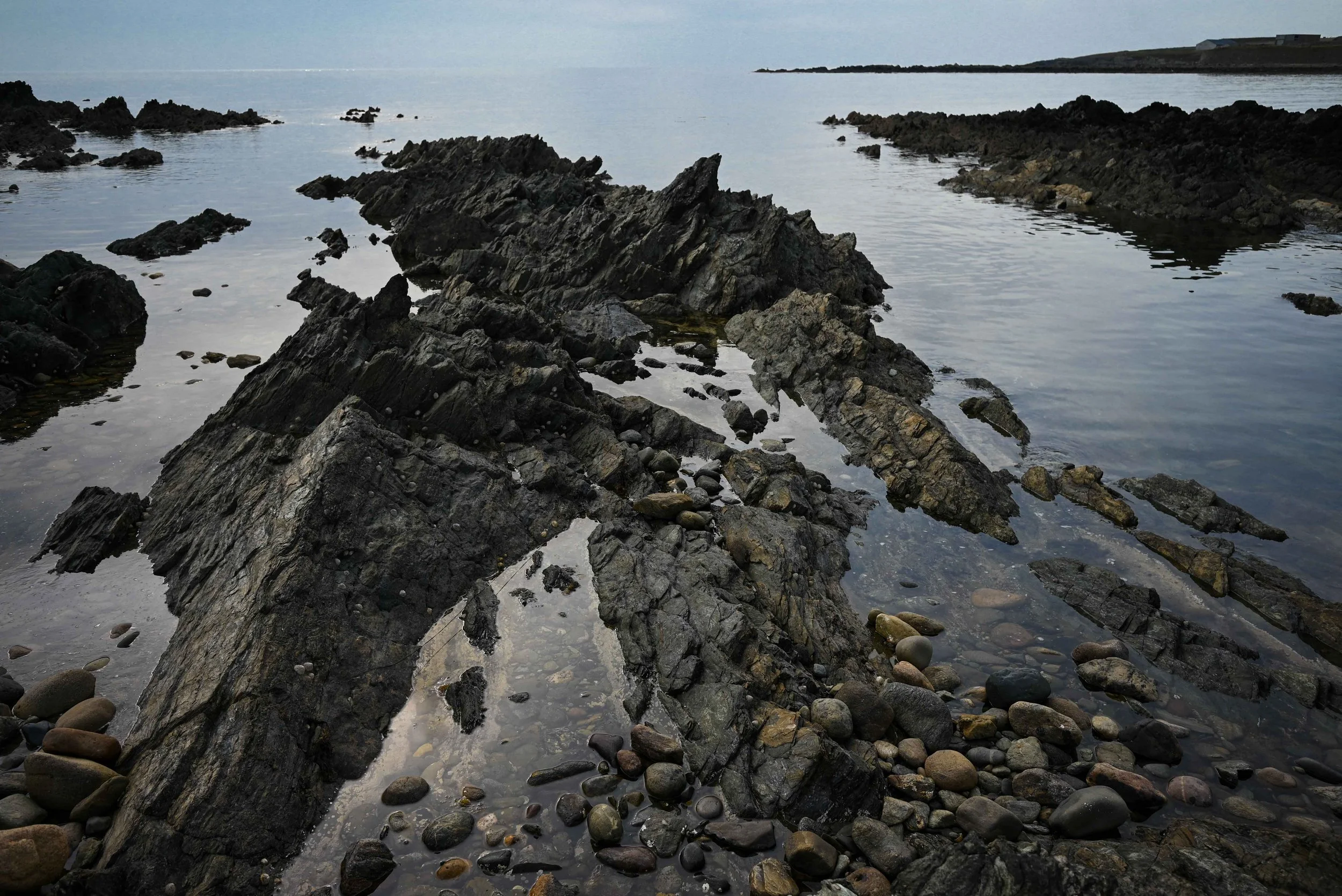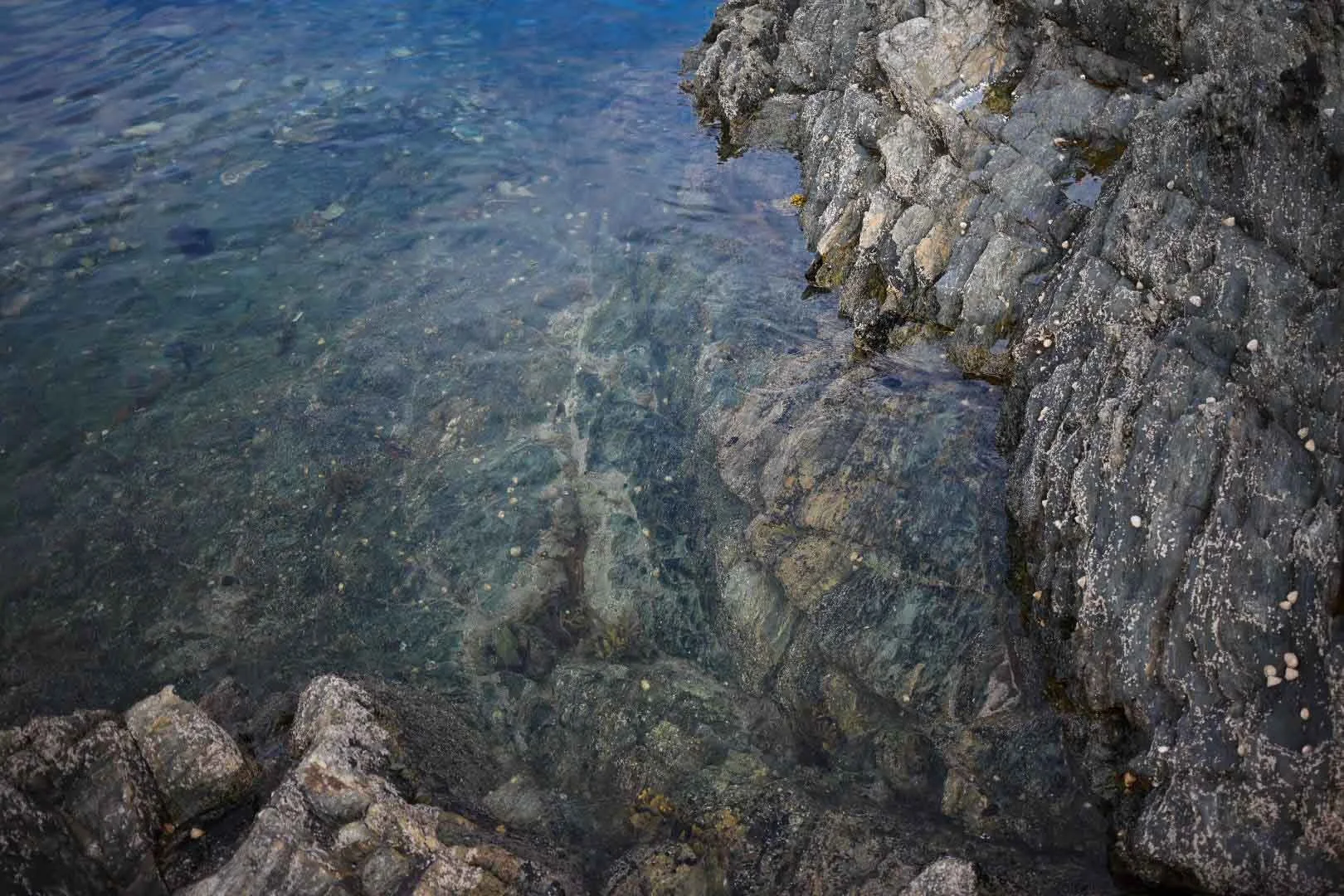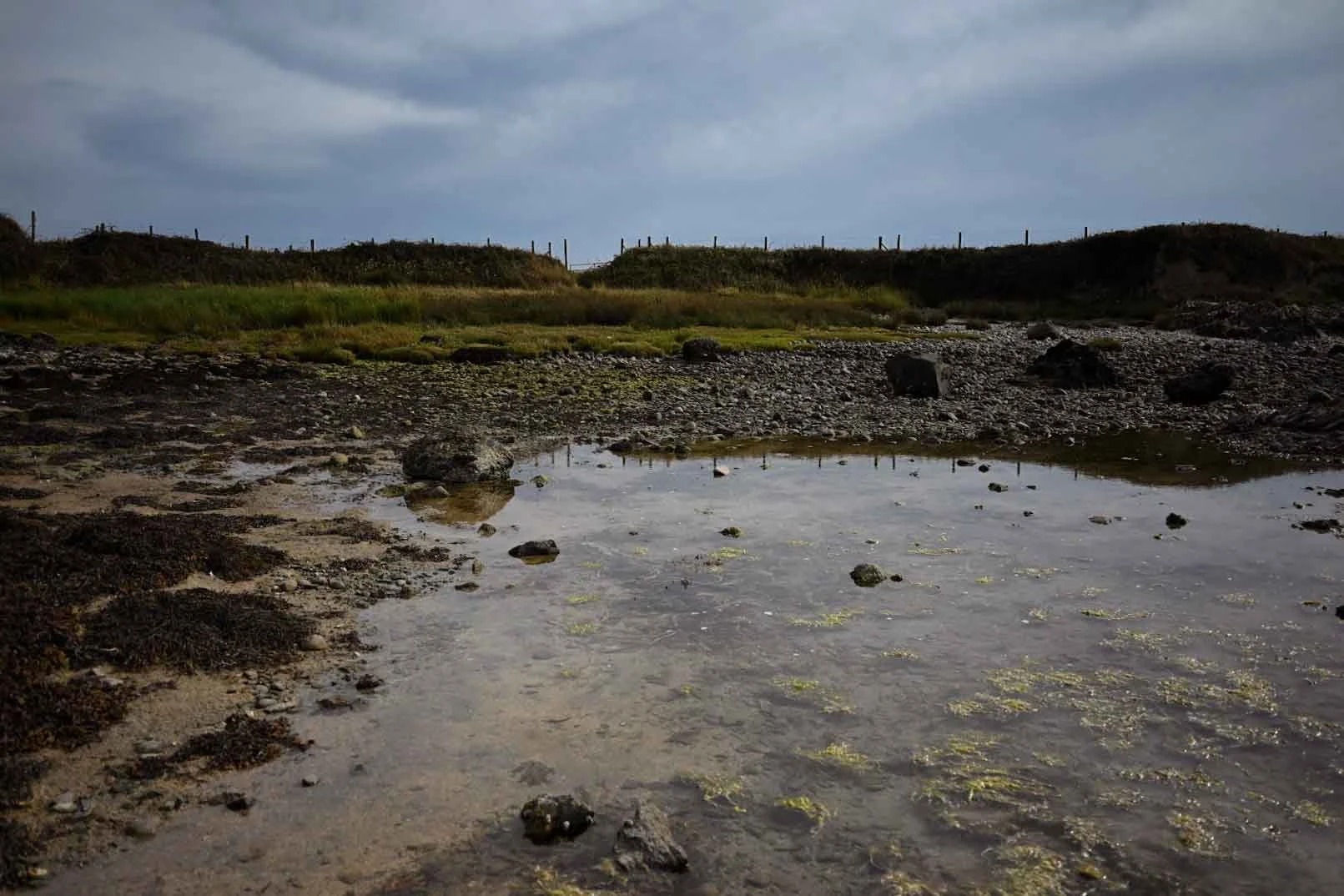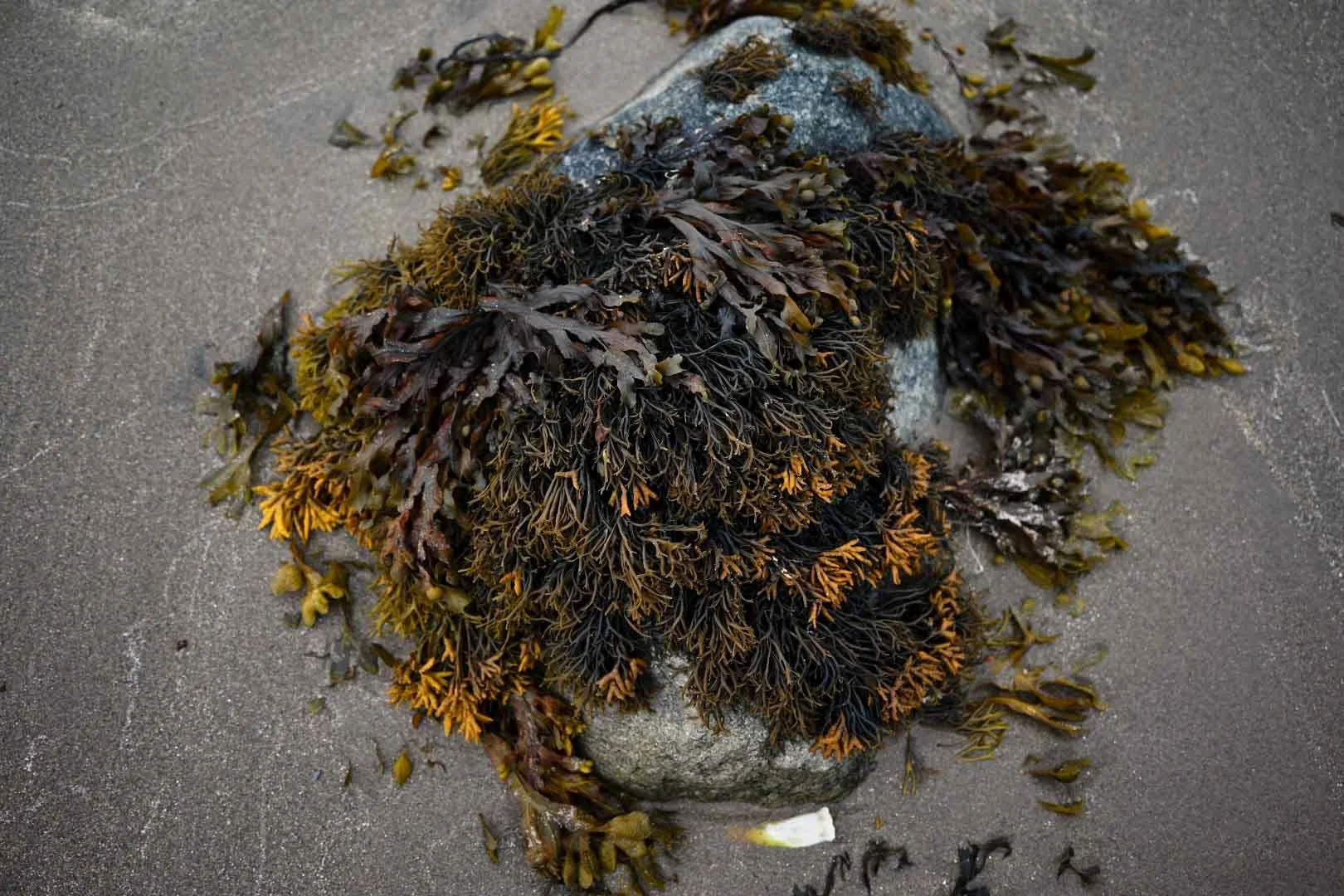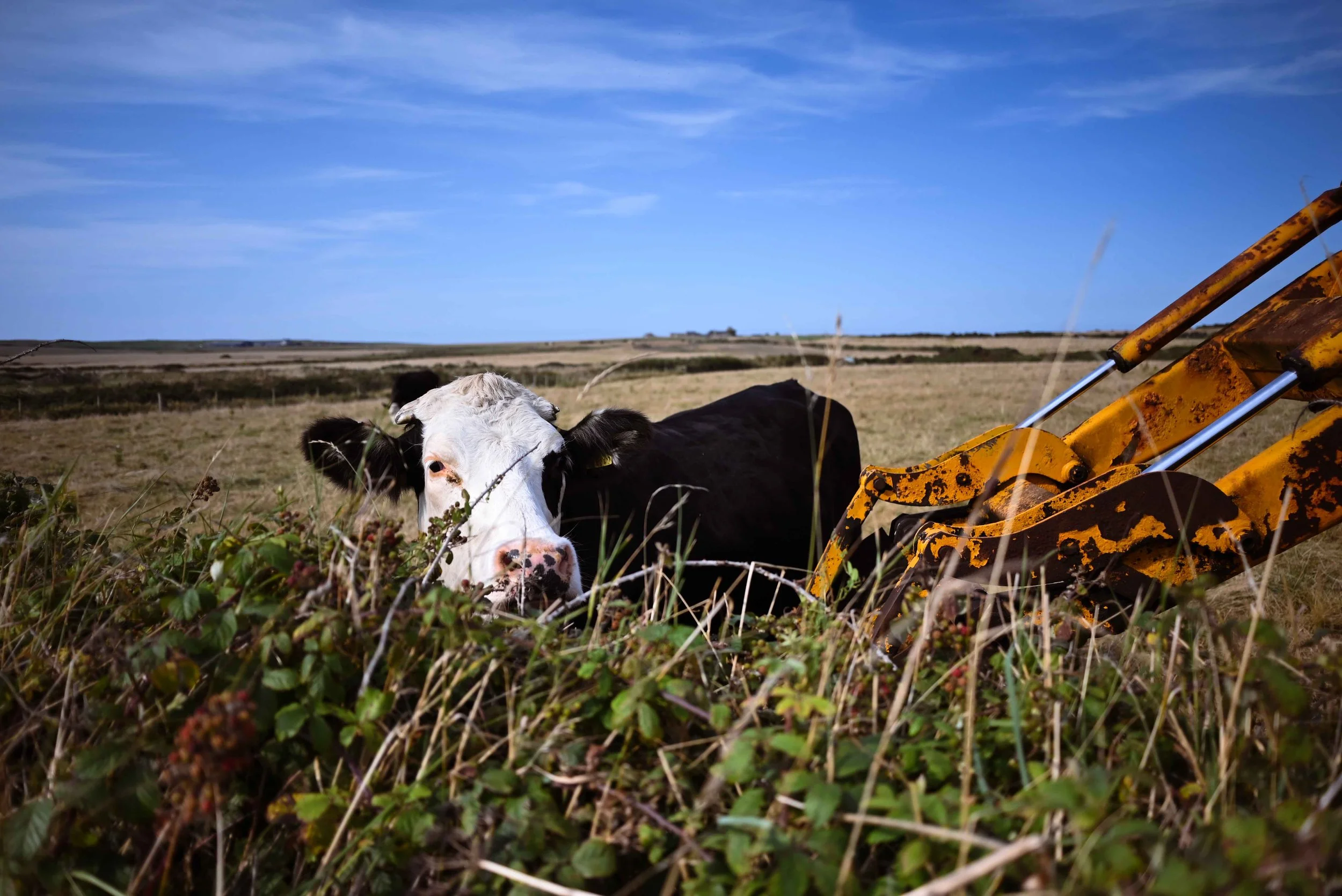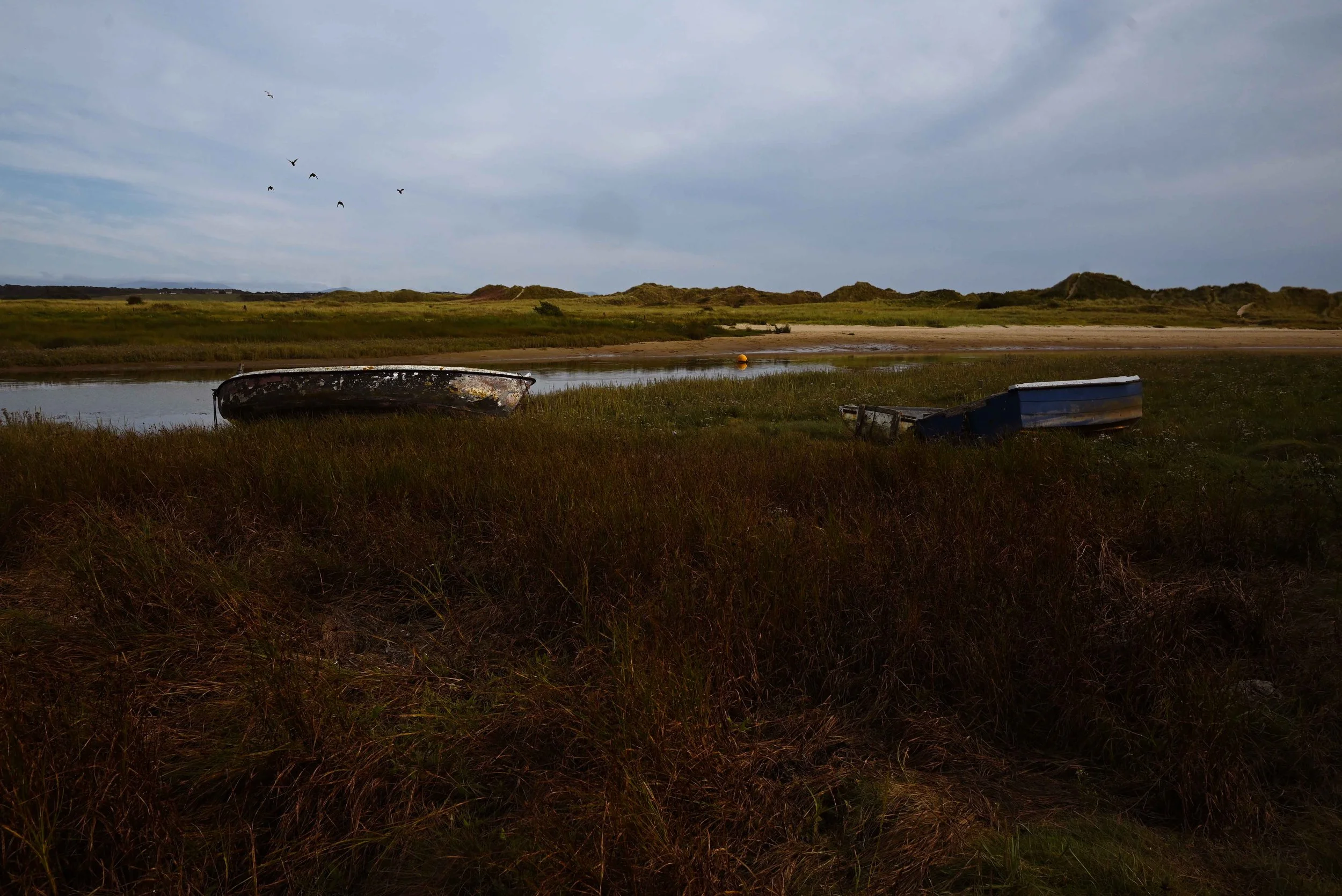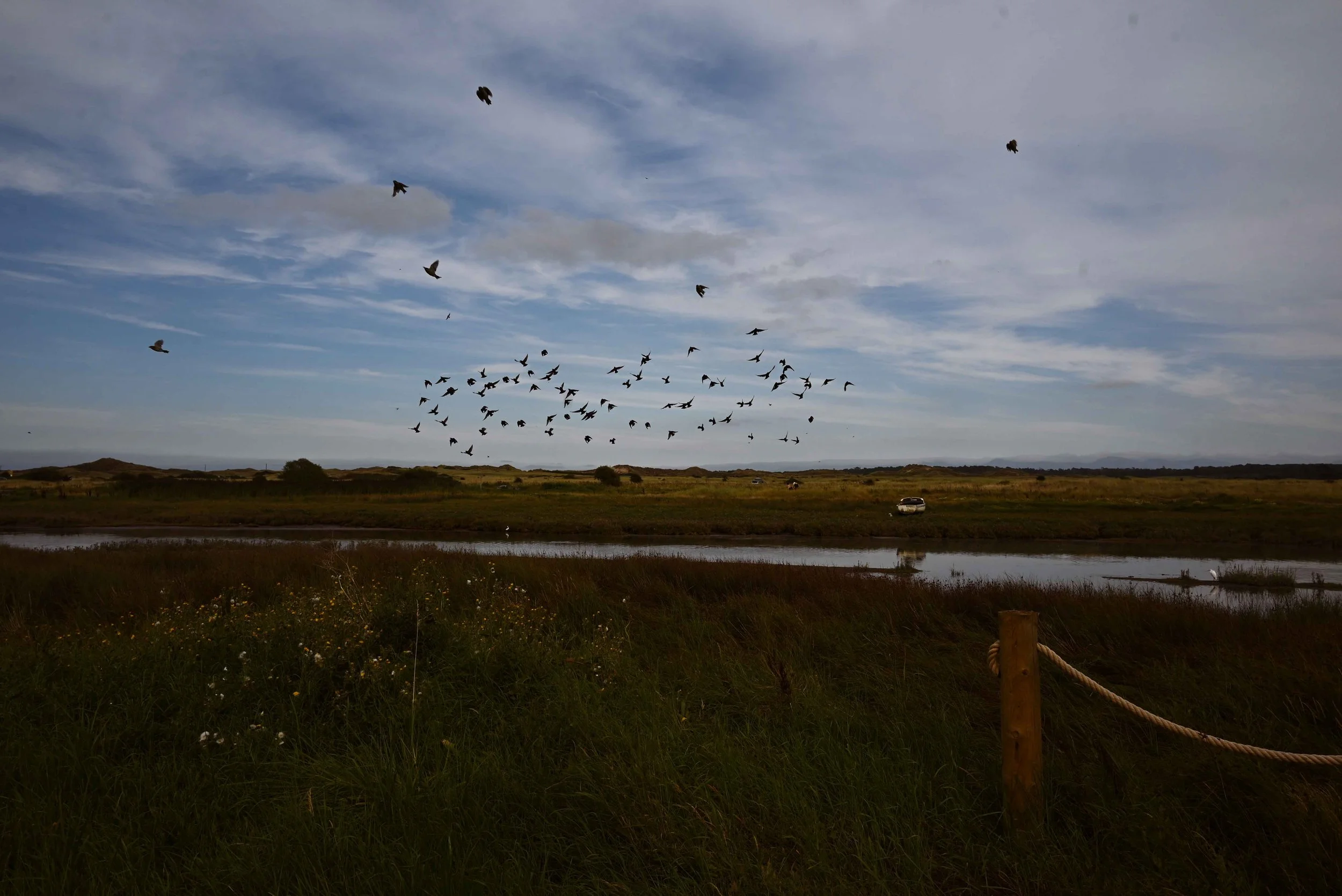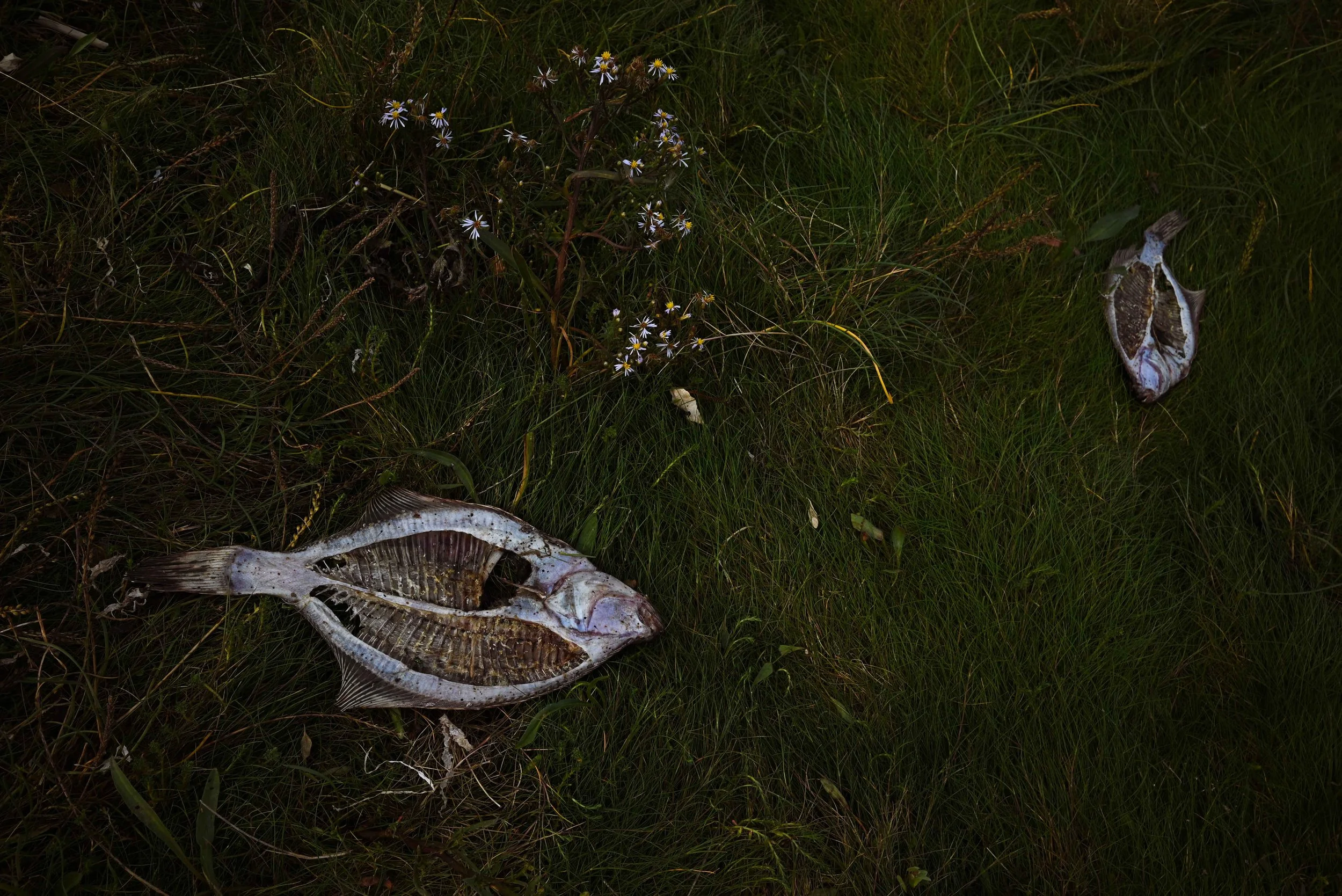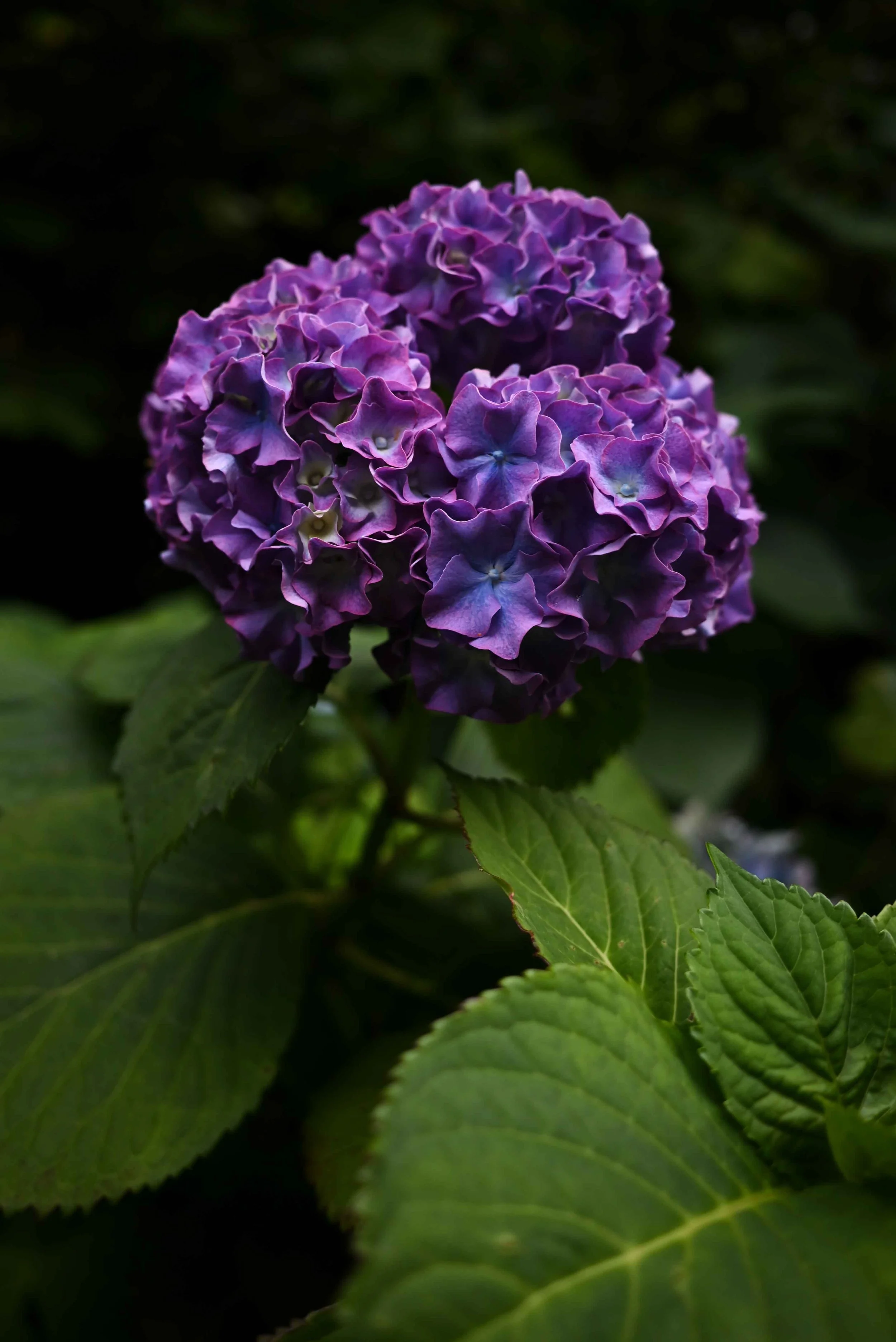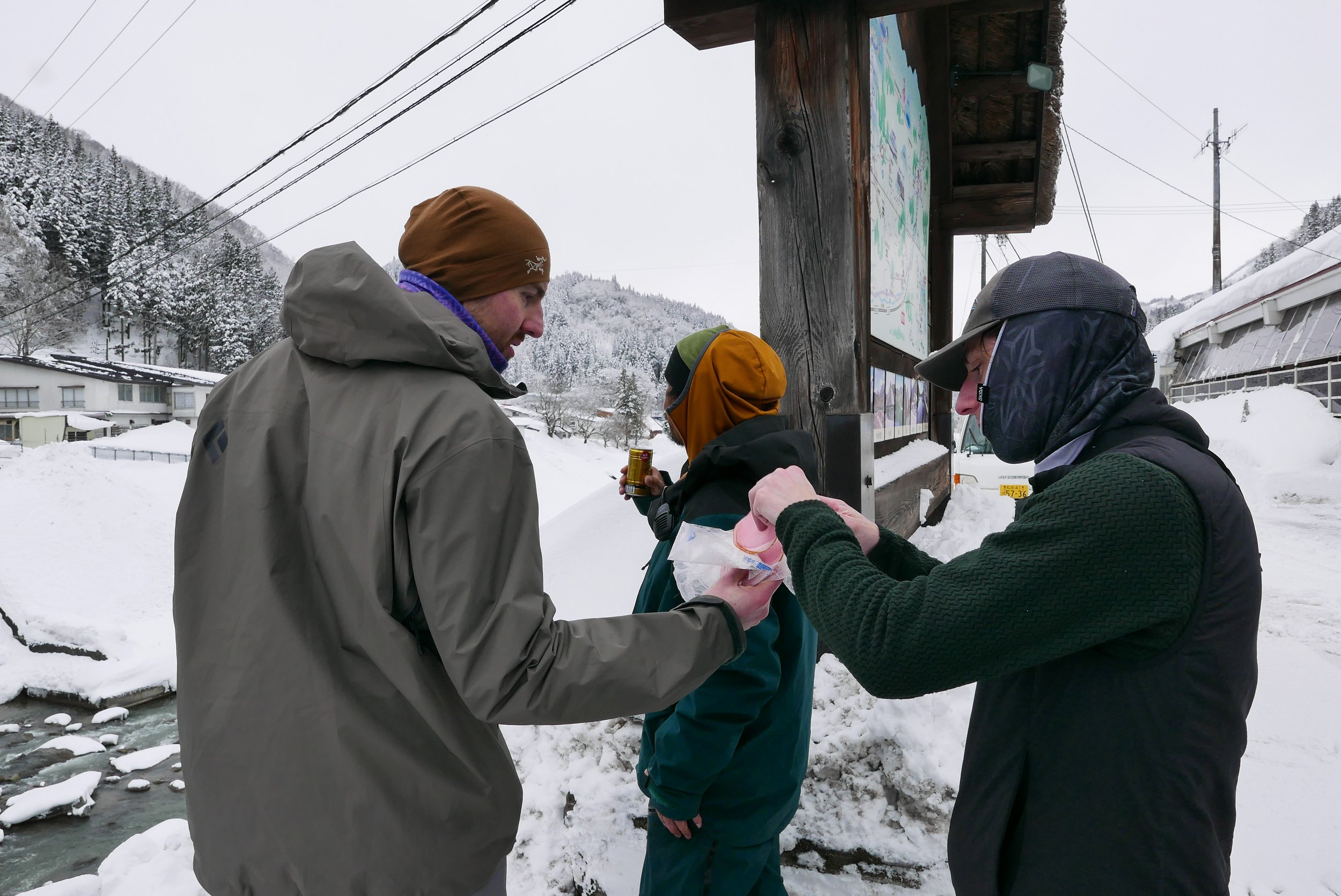phlog
phlog
To beach or not to beach.
Lighthouses guide the way.
How do you start a day when you’ve been woken by the beets of sheep? This was my big morning question.
By all accounts, I hadn’t explored Anglesey enough. So off I went, back down now familiar roads, slightly more comfortable on these winding ways no wider than a New York City sidewalk but with a 60 mph speed limit. I started at Caernarfon Castle, an imposing place with possible mythological affiliations with King Arthur. It is no ruin, and there are plenty of towers and passageways to explore.
From there, I went straight for the farthest point; South Stack Lighthouse. It is on its own little island and is considered a highlight of Wales.
Those who consider and advise did so well. After driving to seemingly the end of the earth I walked down 400 steps and over a bridge up to the unique geological formation that is the south stack. The lighthouse is filled with history, and after a bit of a wait I was able to go up to the top for a full oral history of the place from a lighthouse. The light itself is a beautiful creation of art and engineering. It spins slowly with angles of glass and circles spreading the beam across the oceans.
From South Stack, I went to my next lighthouse destination, Llanddwyn Island. When I got there I found out that it’s part of a beach preserve. I parked and began my walk across a stunning beach. The softest sand with mountains breaking high across the horizon. The island is dedicated to Dwynden, the Welsh Patron Saint of Lovers. It was once the richest church in Wales thanks to many pilgrimages of those seeking support in their love lives.
I spent some time exploring the islandand soaking in the views. I then decided it was time to relax, and try and enjoy the beach. I found a secluded corner and took a dip, followed by a lounge and watercolor. From the beach I took a trip to a dinner of mussels, chips, and seafood chowder, and then back to the campground where I had been the night before for a heart warming night of blissful rest.
Fairytale Beauty.
Crystal clear ocean at the feet of towering mountains, and castles along the way. Wales is showing me a type of beauty that leaves me with few words to describe it.
Sometimes, we talk about things as being “like a fairytale,” but what does that mean? Fairytales are stories. Often with a lesson at the heart, or simply a tale of far off lands we can only dream of. So what does it mean for something to be like a fairytale?
Places that are hard to compare to anything we have seen are the most enchanting, the most fairytale like. Places that are hard to describe because the words we are looking for might not actually exist. Places so beautiful that it feels like they are teaching you something about yourself. That is how I have felt so far in Wales.
I know it seems somewhat gauche. I was just looking at a place on the map literally named “Fairy Glen.” So it’s terribly unoriginal for me to call Wales “fairytale like.” Alternatively, maybe everyone was on to something.
I drove here today from Manchester. And after some time in traffic and some unnecessary detours to castles and churches I saw from the road, I made it to Anglesey. Anglesey is an island in northern Wales. It is beach and it is historic with ancient buildings and it is a collection of scenic points. A large part of the island is a designated “Area of Outstanding Natural Beauty” which is a designation I quite like. Anglesey is also filled with cows, sheep, and horses. Oh, and the roads are 3/4 of a car wide, which I’ve found is standard for a trip where I rent a car.
It is a place that is hard to do justice in photos. On one side you have the sea that is clear and warm, and on the other towering mountains with fluffy clouds. I’ve started trying to avoid description by comparison, but it feels like Alaska, if Alaska was in Provence, or something.
I won’t go into too much detail on what there is to do and see in Anglesey. Aside from myself, currently. I’ve decided that I will be going back tomorrow for a number of things I missed. And in search of more specific words to describe the feeling of incomparability that leads us to think of fairytales.
I’m lying in my tent and have a book to finish, so it’s time to tie a bow on this. But what is that fairytale feeling. We use it to describe places, people, feelings and experiences. Is it just how we describe things that feel like they must be made up? I have no answer now, this is a tomorrow question. For now, something pretty.
Wrapping up Japan, for now
I’m back in New York now. I didn’t give myself much time to sit and write during my final days in Tokyo. And settling back in to life in the city a good blog does not make.
I miss Japan already. Six days of exploring Tokyo to conclude a whirlwind of a trip felt right. It feels like I could spend months walking around Tokyo and still have more to explore.
I got to spend a lot of time by myself, focusing more on my photos and leaving the digital camera behind. I signed up for a soy sauce bottle making class by Kiyosumi Gardens, I believe the area is called Shirakawa.
It was absolutely dumping rain, mourning the departure of my friends. Umbrellas seem to be much more commonplace in Japan, but even with the one I borrowed my boots and jeans resembled discarded towels more so than clothes. The respite came in a spectacular hour of uninterrupted solo park time at Kiyosumi Park.
It I’d a beautiful park, filled with ducks, koi, and frogs. Supposedly, there are many turtles as well. Having been there in pelting rain I would not know.
The following day it cleared up. I had gotten a recommendation to visit St. Mary’s Cathedral, a church designed and built by Tadao Ando. It was on the opposite side of Tokyo, but I made a journey of it.
I am very grateful for this recommendation. The building is stunning. One of those places that stands as a reminder of the artistry that architecture can have. I will include a scan of a negative to illustrate, only because it is necessary for the narrative.
It feels spiritual inside, and in classic fashion, photos are prohibited. A true tragedy for me. I sat and sketched for some time, just being present in the space.
Following this I met up with a new friend, Tori, who I had met at the hostel. She is a photojournalist and was on a photo walk with a friend from Tokyo. I joined them for a short hour. I enjoy walking with other photographers. It adds something new to the flow of looking when there are second and third pairs of eyes thinking in frames.
From there I stopped by the hostel to gather and repack my things and began my journey to the airport. I’ve decided that taking the subway with a ski bag is not that hard, it’s just embarrassing. Being in the way on the train feels rude especially when it’s a foolishly large bag taller than me.
I’m excited to go back to Japan some day. If you’re going, let me know. For now I’m back in New York, a city lacking the order and cleanliness of everywhere in Japan. I will try to continue writing these, though keeping them interesting without photos from Japan will be a new kind of challenge.
I leave you with another negative scan, this one is from Takayama, and really shows how beautiful it was.
I’m now in Tokyo.
To follow up on my previous post, I did see Mount Fuji, and it was awesome inspiring.
I don’t think I’ve ever seen photos of Fuji that have any insight into what is around it, so I was rather surprised from my perch at the train door to see the industrial zone we were flying by. I had sandwiched myself between the two sides of the door to make sure I got a clear shot, not knowing how long I would have while aboard a train moving 178 mph.
I find something beautiful in these smoke stacks and wires that break the view of the otherwise otherworldly mountain. We had a mostly unbroken view of Fuji for almost ten minutes, capping off a day of memorable sights.
Now in Tokyo, it is much warmer than it has been. Today it was nearly seventy degrees, so the cherry blossoms have begun to pop up everywhere.
I can tell that soon they will be miraculous, but people are already lining up to take photos with them. They smell amazing, like honey but warmer and maybe slightly musky.
James went to the train museum, so Lukas and I went to the park. Shinjuku Gyoen National Garden was a sight to behold. Everything is well maintained, so somehow the grass is yellow and perfect instead of the customary brown and dead. The garden reminds me a bit of Central Park. There were a lot of people laying on the perfect yellow grass carpet, groups of children from school, and people just walking around enjoying the day.
From the park we made our way through the Meiji Jingu Shrine and then to Yoyogi on the edge of Shibuya. This is a shorter part of Tokyo with lots of great shops.
We stopped at Blue Lug, a bike shop I’ve dreamed about for many years. I got out mostly unscathed after winning a few arguments against myself on what the difference is between want and need.
From there we went to our hostel in Akihabara to prepare for a night out with my friend Shoyo. Shoyo took us upstairs to a restaurant we never would have found and helped me secure tickets to the Yokohama Marinos game the following day.
The next day James left us again, this time for a flight back to Boston. Lukas and I made our way to Yokohama to start our new lives as Yokohama Marinos ultras.
These fans love their team. The more seasoned ultras jumped and sang in unison for the entire ninety minutes. They had special flags for every occasion. Going to a local sporting event has become one of my favorite detours when traveling.
There was an amazing moment after the game that made it a truly Japanese experience. After the whistle blew no one got up from their seats. We waited, not sure what was happening. The teams shook hands in a line, then got together and bowed to the stadium. Following that, the entire Yokohama Marinos team including mascots did a circle of the entire stadium, stopping three times to bow to the fans. Only after they finished each stadium section bow and left did the fans begin to file out.
The stadium was also a uniquely beautiful bit of brutalism on the outside.
But that is all for now. Time for bed for me, much more of Tokyo to see.
Osaka to Takayama 🚝
And some limited info about Tanuki statues.
I took about three photos in Osaka. There was something about it that just wasn’t getting the shutter moving. Maybe it’s not a great place to visit in February. Great place for shopping though.
This may be a good moment to mention trains. The trains in Japan run like the hands of a watch. You could probably keep time just by watching the trains. When the train arrives at the station you have about sixty seconds to two minutes to board before it leaves. Everyone waits in a very nice orderly line in the special designated paths for your designated car. Culture shock.
We got to Takayama in the evening, and our Airbnb host insisted on picking us up from the train station. She had a sign that said “Aaron” and there’s no photo of it so you’ll just have to believe me.
I found out about Takayama while flipping through a guide book I picked up at the library. I read that it is historically famous for the quality of the trees and talent of the oval woodcarving artisans. That’s about all I needed to make it a trip requirement.
Takayama is tucked away in the Japanese alps. As such, we were back in the snow. The architecture speaks to the trees and talent with very well preserved buildings dating back to the 1600s. The roofs are rounder and raw wood is shown off everywhere, with little adornment needed on the natural beauty.
It’s a small town, but walking through it is a feast for the eyes. So much beautiful woodwork on every home, and quite a few carved deities stand on their pedestals waiting to greet you.
Takayama is built along a river, which is becoming a noticeable theme here. There are canals everywhere, with warm water running through small channels along the sides of the streets. In winter the river is not too deep, with carp visibly swimming in the town center. It is clear that the river gets huge, most likely in the spring after the snow melt covers the banks with rapids we can only dream of (conjecture).
There are many Tanuki statues, another recurring theme. Tanuki are unique statues coming in a variety of sizes representing the Tanuki, which is a Japanese raccoon dog. It’s a real creature, the statues look nothing like it.
Different ones have different meanings but they are generally symbols of good fortune and protection for the home. Different attributes like big bellies or large testicles add on additional layers.
The food in Takayama is also very good. There are many local specialties including Hida beef, and Hoda Tofu. You can’t get either from a vending machine but there are lots of vending machines for snacks and drinks as always. Not sure what I will do back home without them.
The blending of old and new is a little different here. In most of the central areas the only “new” thing you can see are cars. The old architecture is remarkably preserved. Our Airbnb was an old building in the historic district that had been modernized in some ways internally with mini splits and a fancy shower, but from the outside you would never know.
Before catching our train, Lukas and I made a quick detour to the Hikaru Museum. It was a forty minute walk into the hills, and when we got there it seemed closed. It turns out the museum is almost entirely under ground.
The building was breathtaking. It is built around a central indoor courtyard with a pyramid roof.
I could have come to the museum just to enjoy the building. The fountain in the middle of the courtyard can be heard in every room on that main floor, which doesn’t really make sense. Lukas put it well, it feels like surround sound water.
The main draw to go was the opening of a new exhibition of Hokusai’s thirty-six views of Mount Fuji. An amazing print collection including the world famous huge wave.
As we stepped out of the shockingly awe inspiring subterranean home of arts we were greeted by a sunny day and clear skies all the way to mountains we had not yet seen.
As I write this now we are on the train to Nagano, and then quickly transferring to Tokyo. We will hopefully be enjoying our own thirty-six views of Mount Fuji from the western side of our train car in the next few hours.
Around Kyoto, featuring gardens, temples, shrines, and plenty more beautiful things.
I’ve realized I’m behind on the Phlogs. It’s hard to keep up with these when you’re having fun, and sometimes I just don’t have time to edit and write.
The time zone is also quite confusing for me. I typically experience two days in the New York time zone for each of my one days here. Hence the strange posting time and likely incongruous arrival of my communications.
The other day I took a bus to a less touristy part of town in search of a temple that was recommended to me, and an art museum. I made the foolish decision to not eat breakfast before going to the bus stop, so I stood there for quite a long time with my scrambled eggs brain watching the busses go by. At some point I realized I should board one, and this is how I found myself at a beautiful, empty place I could not tell you the name of.
Kyoto is beautiful in that way. You just walk and stumble upon things you weren’t expecting expecting. For me it also means I never arrive places at the time I planned.
I ambled my way in the direction of Hōnenin Temple. I heard that it is quiet and secluded. My indirect route took my through a large square with Museums, theaters, and a man surrounded by excited pigeons that he was feeding.
I found myself suddenly drawn to brightly colored buildings across the way. I found out it was the Heian Jingu Shrine, home to a winding garden with countless ducks, ponds, and streams.
I took my time walking through. It was incredibly peaceful and I felt miles away from the city. The air felt different, it tasted good, there were very few people around. I crossed bridges, carefully stepped my way down narrow, winding paths.
Eventually I came back out and spotted something that I’ve found is quite common in Japan. A collection of technology that seems both very futuristic and very antiquated all at once.
By this point I was more than a couple hours past the time I’d expected to be at Hōnenin Temple so I booked it straight into the hills. I was now in a mostly residential area, walking up some pretty steep grades, something that seems to happen to me predictably often on vacation.
As I reached the ridge of the hills I was met with the Google maps waypoint for Hōnenin Temple. Also predictably, it was not there. There seemed to be a shrine behind some walls, but it was clearly closed. I decided to keep searching. The ridge line was full of shrines, a new one every 100 meters or so. They were all somehow related to Hōnenin, so I figured I’d find the temple eventually.
When I did, I thought it was just a garden. What started as a moss garden opened up through the trees into the picture of tranquility. A smaller temple with just a few buildings all covered in moss.
I could not go into the temple, and much of the grounds were not open to the public, but it was well worth the visit.
I made my way back down the hill, stopping briefly for some local duck and mushroom soba soup before setting my sights on an art book and zine store I’d been told about. Many Yen later I was on the move to the Kyocera Art Museum. Along the way I was greeted by a collection of shrines and a monkey wearing earmuffs.
My experience at the art museum was painful. I accidentally booked tickets for a new exhibition that is apparently very popular. I mostly stood in large packs of people airing for everyone to take selfies or posed photos while suffering from high heat and a lack of air.
You can see mountains from almost everywhere in Kyoto. And I haven’t spent enough time looking at a map, but it feels like there are rivers and canals in every direction.
From there I had to hustle home, James, Lukas, and I had a dinner reservation that had involved a delivery of American whiskey two days prior to get. It was a French inspired omakase that we shared with a couple from Kyoto at the five seater space down an alleyway.
It was spectacular.
Sunrise at Fushimi Inari
Not many words to describe this, but join me on my walk that began at 5:00 am.
Fushimi Inari is a Shinto shrine dedicated to Inari, the Shinto god of rice. Foxes are said the be the messengers of Inari, so the whole area is filled with fox statues.
Fushimi Inari is set on a mountain side, and is largely famous for the thousands of red Torii gates that arch over the trails up the mountain. The arches are sponsored by companies and individuals, so the words on the sides are the dedications.
This Shrine and the path up the mountain is also known for being completely overrun with tourists. We’d heard that it is best to visit early in the morning or late in the evening to avoid the crowds. We opted for the morning. This is sunrise at Fushimi Inari.
The trail winds up the mountain to a shrine at the top. It ducks in and out of the woods so even once the sun had partially risen, there were still areas shrouded in darkness. In the dark, surrounded by woods the red gates tower over you in an eerie way.
This seems to be a popular route for running in the morning, which feels unusual for a holy place in Japan. The deafening silence would be broken every now and then by the swift footfalls of another runner making their way up.
Japan is also filled with vending machines. I may get into this more later, or you may have noticed their prevalence in previous photos. Even shrines have them. This Kirin one was about halfway up the mountain.
This handwashing station was near the top outside a smaller shrine. Handwashing is traditional before prayer in a shrine, and many of the basins are adorned with animals or other beautiful carvings.
There was a breathtaking view of the sun rising over Kyoto near the top. I did not photograph it, as it was meant for the eyes and not the lens.
Fushimi Inari is beautiful and the February off season and early morning made for an unforgettable start to the day.
A first day in Kyoto, the place where I’m not allowed to take photos.
I’m sitting cross legged on a bench with no shoes on waiting to watch a video. The floor is freezing, I had to take my shoes off, and there are no slippers.
So goes visiting cultural sites in Kyoto. I’m currently in the Honmaru-goten Palace at Nijo-Jo Castle. It’s spectacular, I wish I could show you, but photography is prohibited practically everywhere. To be a photographer in Kyoto is like being a chef mid fast. Given the lack of photos, I will do my best to describe what I can with words and facades of buildings.
We began the day with a tour. We found another Kazu to be our guide and this Kazu was as good as the previous. We explored temples, shrines, and the Geisha neighborhoods while learning some of the history of Kyoto. Apparently, Kyoto is known even locally as having a lot of rules.
Our tour took us through Yasaka Shrine and Chionin temple. Shrines will often have many food vendors just inside the gate with all kinds of snacks to go. Shinto shrines are typically very orange, so the combination of the shrine and the brightly colored food vendors is a lot to take in.
At Chionin Temple we were able to light incense and make a prayer. Wafting the smoke over you from the incense is supposed to be good for wisdom and back and head pain. Upon hearing this, half of the group rushed over to the incense.
The shrines and temples here have lots of different ways to pray or perform a ritual and lots of charms you can buy. Most of them have very specific purposes and meanings and people will often go to a specific one with a specific problem.
We have been very lucky to experience almost no crowds at a lot of the places we visit. It’s cold and windy, but a photo of the steps where Tom Cruise filmed The Last Samurai with no people on it is a rarity (from what I hear).
Just walking along the streets here is an adventure. There is something hidden behind every corner and beautiful artwork everywhere. After our tour we explored central Kyoto. Eventually making our way to Nijō-Jo Castle.
The entrance gate is adorned with beautiful painted wood carvings. This gate is about the end of what I was allowed to photograph, but the castle was beautiful.
Nijō-Jo is where the Shogunate initially took power, and also where they were removed from power, so it is a place of immense historical significance. It was eventually converted to be an imperial residence, so it is decorated with painted walls depicting tigers and seasons and mountain ranges. Each room has its own theme. The grounds are also beautiful and the replanting was directed by Emperor Meiji.
The tigers painted in the tiger room are quite interesting. At the time that they were painted there had never been a tiger in Japan. The artists based their tigers on tiger hides and pictures of tigers that they had from China and Korea. The tigers are a little funky looking.
The end of our castle journey had this water spout. They really do incredible things here with cement.
Kyoto at Night
Our Airbnb is in an area that seems to be historic, but that might just be this whole city. We are quite close to many temples and the area where the Geisha’s live. After a second, or maybe third dinner, James and I got a second wind, sending us into the frozen night. There was practically no one out on the streets.
We would cross paths with the occasional pair of tourists or a Geisha hurrying home, but otherwise, it felt like Kyoto was a ghost town.
The brightest lights came from vending machines, which are everywhere in Japan. There is a bathhouse around the corner from where we are staying, it is equipped with vending machines. There is a liquor store as well. It too, is equipped with vending machines in case you don’t want to go inside.
We made our way to Yasaka Shrine, a nearby Shinto shrine with many smaller shrines to pray at as well as big bells to ring.
The smaller shrines are considered homes for the god, whose being can be there if it chooses. There is a very specific set of rituals including tossing a coin, hand washing, bowing and clapping to pray at these shrines.
The shrines are guarded from evil by gates as well as statues of dogs and many other spiritual elements.
Almost all the shrines we have encountered are sponsored by companies. For instance, the shrine for the god of beauty is sponsored by one of Japan’s biggest cosmetic companies. The beautiful white and red lanterns are all sponsorships by companies who want their name on the shrine. There seems to be a very unique relationship between business and religion in Japan. With sponsorships as well as praying traditions for good fortune in business.
I was not able to photograph most of the shrine due to rules.
Bonus content
Evening at Nishiki Market. A bustling place that seems to be mostly a magnet for curious tourists. Filled with every kind of food and shop you can imagine with prices much higher than you’d hope.
A train ride to Kyoto, and a bus.
We dropped our skis for shipping and got ourselves on the road to Kyoto. It did not stop dumping snow the whole time we were there.
The bus felt like a ski bus to a winter wonderland, until suddenly we came out of a tunnel into a world of green grass and beautiful trees and practically no snow.
the drive kept getting more complicated, from snow to summer all along the coast of Lake Biwa.
The bus took us to Nagano and we got on a train to another train to another. Upon arrival in Kyoto we realized we had made a critical error with our tickets preventing us from being able to leave the station. This led to an intercom call and an extracurricular trip to Kyoto station for me. There was plenty to see along the way, from small cars in impossibly tight parking spaces to candy shops with sweets in the shape of anything you can imagine. Things that are so intricate that you can’t be sure they will taste good while simultaneously dying to put them in your mouth.
Kyoto is a beautiful city, in a very different way from Tokyo. While Tokyo is tall and highly stimulating, Kyoto is shorter and full of old beauty. Around every turn is a shrine or other historic building. Even the houses are beautifully built. Canals run throughout the city and it feels like we are constantly going over bridges.
We are here for the next few days, and it seems like there will be no end to the possibilities of exploration.
Two days of endless powder 🌨️
Our guide, Kazu, said more times than I can count, “this is every day here!”
We spent Tuesday touring the backcountry of the north side of Hakuba Cortina. Kazu is a next level guide. He’s a professional freeride skier and as his friends described him in one of his films “a great skibum and a hardcore guy.” He started skiing when he was three and grew up in Hakuba, so he was really touring us around his backyard.
Every line we skied was fresh, untouched powder. It was cold, but we were floating through 50cm of snow that carries you like ocean waves.
We saw almost no one else in the snowy woods. We often climbed in silence, enjoying the chilly quiet among the birch trees.
After a full day of the Hakuba woods we came out into some snowed over rice fields and then carried our skis a little while to the bus station.
A snowy snack and a cigarette later we were back.
Today Kazu took us around the resort at Iwatake. The avalanche risk was way too high to go into the backcountry, but Kazu was able to find us endless untouched powder lines through the trees and areas that were less open.
It was a truly spectacular day of skiing with all of us getting some of the best runs of our lives. Hakuba is in the Japanese Alps, known for steep slopes and deep powder. The tree runs were like cliffs, but the pillows of soft snow all around made flying down them feel like floating through a different universe.
Tomorrow we head to Kyoto in the morning. Hopefully we can get out of bed. The soreness has already set it.
Japan day 2, we’ve arrived in the snow.
We began our day by sleeping in and then rushing with our bags to miss the express train from Matsumoto station. Seeing the city in the light of day was beautiful. The city is both metropolitan but also filled with older traditional Japanese architecture and narrow winding streets. Mountains surround the town and everywhere you look is like a postcard.
We were able to find a different train not too much later, a local one with just two cars and stops about every 10 minutes.
About 45 minutes into our journey it began to snow. What started as a light flurry quickly became a squall that made us feel like we were on the Polar Express.
The snow just kept getting deeper and heavier. Even the locals were jumping up to take videos and photos.
The train station where we disembarked was not the right one. It did, however, have a booth for boots and slippers.
By the time we got to Hakuba we were in a polar world the likes of which I’ve never seen. Snow banks well over eight feet tall and roads so icy it’s hard to walk on them.
We went on a foolish walking adventure down the very steep, narrow, and winding road to our hostel in search of food. Slipping and sliding our way down wishing we had put our skis on.
Tomorrow we are up early to ski. So much snow has fallen today on a crust that the avalanche risk is high, so we are staying in bounds. The powder should be well above our waists.
A first day in Japan 🇯🇵
A first day in Japan. Flying around Tokyo taking everything in.
It’s hard to tell at this point, 11:30 pm Matsumoto time, how long I’ve been in Japan. After a typical battle with JFK airport and a spectacular flight to Haneda airport I arrived in Tokyo at the dark hour of 4:30 in the morning. I made my way arduously through the Tokyo subway from the airport to Tokyo station, dragging my ski bag and luggage behind me. I picked my way through a bustling station full of other people carrying skis, but with places to go. Tied down by my luggage, I had nowhere to be so I made myself comfortable on the plaza outside the station, waiting for the luggage storage to open.
At 7:00 am I dropped off my luggage and sprung freely out into the streets of Tokyo. Unlike Tokyo Station, the streets were practically empty.
I love the morning light. It was a beautiful time to be exploring. Too tired to form a plan I pointed myself towards the hostel my friend James was staying at and began meandering in circles towards it. James will be a recurring character in this story.
What followed after finding James was a feverish day of ravenously taking in Tokyo. We ate 4 times, myself 1 extra. We walked many miles across the city and discussed the merits of a solely vending machine based photo project.
There are vending machines everywhere in Tokyo and selling all kinds of things. They pop up where you least expect them and are always where you do.
Tokyo is something like a kaleidoscope of marvelous things to look at. I could hardly walk ten steps without finding something to marvel at. A tank of fish, a beautiful temple, a cafe covered in leaves. Not to mention a flea market of antiques that nearly made me cry in limited luggage space.
The architecture is also breathtaking, with seemingly every building bringing some new design feature, new, ancient, or brutalist.
James and I eventually made our way to the imperial palace grounds. Beautiful even in winter, and expansive in a way that’s hard to explain.
The imperial gardens were filled with gorgeous plants, citrus trees, and even some early blooming cherry blossoms. It’s hard to imagine what it was like to live with such a big yard, and the palace itself is long gone, so it’s hard to imagine that as well.
We eventually made our way back to Tokyo Station to meet up with Lukas who had just arrived. At 5:00 pm the station was completely packed and navigating through was quite challenging, but we all eventually made it on to our train to Nagano, where we will be skiing. We were greeted at a lovely hostel and told about a light show at the castle, something normal for Japan. We quickly ran to catch the finale and then stopped by a shrine on our way to grab an evening snack.
We are now all delirious and tucked into comfy beds. I don’t remember the last time I was in one of these.
Keep your inbox tuned to this here channel. Many more days of Japan to come.
A trip home
My dad died recently. Not much to say about that at the moment, but I have been spending some extra time with my mom in Boston.
The nature of being home has changed, the time spent with my mom and other family members is different. I usually drive to Boston, but this time I took the train. My thoughts are feeling very scattered and it has made driving hard.
I’d never been on this train route during the day, and my perspective on Connecticut has been changed for the better. I never knew how picturesque the Connecticut coastline is. Passing through the quaint towns filled with boats at sunset was a lovely way to get lost in thought.
At home, I spent a lot of time walking. On my first night, I walked with my friend Nick to grab some food. We passed by some work on the pipes under the street which involved a running fire hydrant. Don’t ask me.
My mom and I share a dog. This means my mom has a dog and she says sometimes that he is my dog, and in fairness, I did grow up with him and I do take care of him when I’m home (he is my mom’s dog). He is the primary instigator of walking and I appreciate him for that. Someday there will likely be a photo of him on this Phlog.
While at home we also went to visit the cemetery. My mom chose a spot right next to a lake. It is a beautiful place that I know my dad loves. There are often ducks and the trees growing out of the banks are a beautiful mess of gnarled branches.
One day the weather was nicer so my mom and I took a field trip to Carson Beach. Carson is a place I often overlooked when I was younger, but the path along the water is perfect for elderly dogs. It had been raining heavily, and snow had been melting, so there was some flooding. We walked for a while and were eventually turned around by the wind from the far side of the JFK Library. On the way back we collected sea glass. My mom says she will use it to craft.
On the way home we decided no field trip would be complete without a stop for some food. For some reason, I felt compelled to intentionally miss my turn in lieu of a less efficient route, and we were immediately greeted by the most incredible rainbow I have ever seen. I wish a camera could do it justice. It filled the entire width of the street, like nothing I have ever seen. It was almost like an AI generated image of a “gigantic rainbow the size of a street invading the city of Cambridge.”
I suspect I will be in Boston a lot now. The change of location might be good for my photos.
Right before I left it snowed.
Aaron
A camera in my pocket
A camera in my pocket and thoughts on looking at everything
Not to be too repetitive, but I recently found myself with a new photo machine. Recently, I have been leaning into the idea of constantly carrying a camera. Taking photos with my phone has always felt wrong to me. I feel like they get lost forever, and they never quite look right. I also don’t like when a photo-capturing device is so full of technology that it tries to outsmart me. Which my phone certainly does.
The camera I am lucky enough to be using now as my everyday carry is a Ricoh GR IV Digital. It is an older camera, but it is spectacular. The sensor is smaller, the megapixels are lower, but for me, it is perfect. I have so much control over almost every facet of the camera, and it has a wonderful little flash.
Always having a camera in my pocket makes me feel so on it. I am constantly looking for frames. I used to only use film cameras in this way. But the freedom of digital lets me take more pictures I might typically skip. I look more closely at leaves, advertisements on walls, and trash. Who knew Green Day and Selena Gomez’s Rare Beauty could be such a beautiful visual colab.
As photographers, we have to look at things a little differently. The most exciting images could be of the most mundane things. Henri Cartier-Bresson was the master of turning the normal into something captivating. Even if the camera stays in my pocket, I am always on the lookout for anything I find interesting to look at. A smashed pumpkin under a parked car. A discarded Christmas tree. The cat statue tilted in an almost bodega cat manner among bundles of sage. All of these things brought me brief moments of excitement. They are slight blips in this pattern-filled world that speeds by so quickly.
Trees are magical and provide so many different “lewks.” From close up gnarled limbs looking like faces to looming entire bodies from below. They can be both so comforting and so intimidating all at once.
Sometimes you have to find your own excitement. And looking for the little things that are different is my favorite place to start. And go hug a tree, you never know what kind of mood that creature is in.
That’s all for now,
Aaron
On a Walk
I try to get out for a walk every day. Unless it’s raining.
I try to get out for a walk every day. Unless it’s raining. Or some other form of wet and grey. I am like a plant that needs proper amounts of sun and time around other plants. Another thing about walking is the slow pace that allows for observation and experiencing everything around you. Aimlessly wandering is one of the best ways to connect with a place.
Many of my favorite walks are along the water, but I also love slowly walking through the quieter neighborhoods of Brooklyn. There is something so peaceful about tree and brownstone-lined streets where you’re not constantly dodging other people.
My micro-neighborhood is currently the home of a never-ending number of construction projects. If I am ever lost it is easy to navigate home by looking up and searching for the highest concentration of cranes. While part of me is grumpy about the construction, there is also something oddly beautiful about it.
Trees might be one of the most underappreciated residents of the city. Any time of year they have a unique way of living with us. In the winter without their leaves, they are a beacon of hope for spring to come. I can spend ages looking at the intricate patterns made by branches crisscrossing the sky.
I find it’s always easiest to find subjects in new places, but exploring home is exciting too. It helps me focus in on all the hidden beauty hidden around me. It’s also nice to have an activity to get myself outside. Spotting something new close to home is a special kind of thrill.
That is all for now and I hope to see you on my next walk!
Aaron 🤠
serendipity 🤭
A tale of a rediscovered camera
Wintery blue skies in the lower east side of Manhattan, New York.
This was on the CF card when I first turned on the camera. The timestamp is June 23, 2009, and that is me, age 12, on a family trip to England.
I recently found an older Nikon Coolpix 3100 in my mom’s basement. It was bought in the early 2000s for an upcoming family vacation, and I never remember it being used. My dad started his career as a photojournalist, so carrying around laughably large cameras was standard. He always encouraged me to shoot with his DSLR, so at the time this camera made a very small impression.
While the Coolpix was never my camera of choice, it has been a joy to rediscover it. I love how tiny it is. The only reason I grabbed it in the first place was the size and the fact it takes AA batteries. Running on AAs makes a camera feel like a fun little toy.
Once powered on the Coolpix was suddenly filled with fun features. The first was the 128 MB CF card. I usually shoot with a Nikon D780, so I am used to individual files almost half that size. After a deep dive into the very limited menu, I was very excited to find some very weird and fun modes including “Group Right”, “Portrait Left”, “Sport Composite”, “Portrait Couple”, and many more.
While I don’t love this camera, I’m having a great time making the most of what the 3MB sensor offers!
I love when the moon is out during the day. I also love power lines. I stopped to catch this mass of geometry on a walk with my mom in Cambridge, Massachusetts.
The following collection is from a trip over the Christmas holiday to visit my aunt and uncle in Waitsfield, Vermont. I was very impressed with what the camera produced in low light and funky fog conditions.





This final image is using the camera’s “Sport Composite” mode. These little contact sheets are pure gold. I wish all cameras could do this. They seem to completely kill the battery, but so cool! This person was preparing for upcoming Lunar New Year celebrations in Chinatown, New York.
That’s all for now, thanks for reading! Come back again :)
Aaron
